Evaluation of Production of Digital Twins Based on Blockchain Technology
Abstract
:1. Introduction
2. Literature Review of Blockchain Technology and DT Products
2.1. Management of DT Products
2.2. Blockchain Technologies
2.2.1. Peer-to-Peer Networks and Blockchains
2.2.2. The Hash Algorithm in Blockchain Technology
2.2.3. Transactions in Digital Twin-Based Blockchains
2.3. Blockchain Technology-Based Digital Twins and Uncertainty
2.4. Applications of Blockchain
3. Enhancing the Production of Digital Twins by Analyzing Challenges in Blockchain Adoption
4. Evaluation Model for DT Products Based on Blockchain
4.1. Methods and Data
- Personality conditions: The personality conditions depend on the decision-maker’s perspectives, policies, and professional conscience [4].
- Environmental conditions: The uncertain and unclear conditions in real situations are unpredictable, e.g., changes in economy, technologies, society, epidemics [19], and crises.
- Multiple criteria and alternatives (MCDM): these are complex situations for decision-makers and are composed of various forms of factors, either quantitative or qualitative [18].
4.2. MCDM Analysis
4.2.1. Analysing Criteria Using OWA
4.2.2. Analysing Alternatives Using TOPSIS
5. Empirical Study
6. Model Simulation
7. Conclusions
Author Contributions
Funding
Conflicts of Interest
References
- Hasan, H.R.; Salah, K.; Jayaraman, R.; Omar, M.; Yaqoob, I.; Pesic, S.; Taylor, T.; Boscovic, D. A Blockchain-Based Approach for the Creation of Digital Twins. IEEE Access 2020, 8, 34113–34126. [Google Scholar] [CrossRef]
- Huang, S.; Wang, G.; Yan, Y.; Fang, X. Blockchain-based data management for digital twin of product. J. Manuf. Syst. 2020, 54, 361–371. [Google Scholar] [CrossRef]
- Perera, S.; Nanayakkara, S.; Rodrigo, M.N.N.; Senaratne, S.; Weinand, R. Blockchain technology: Is it hype or real in the construction industry? J. Ind. Inf. Integr. 2020, 17, 100125. [Google Scholar] [CrossRef]
- Abdel-Basset, M.; Nabeeh, N.A.; El-Ghareeb, H.A.; Aboelfetouh, A. Utilising neutrosophic theory to solve transition difficulties of IoT-based enterprises. Enterp. Inf. Syst. 2020, 14, 1304–1324. [Google Scholar] [CrossRef]
- Sikorski, J.J.; Haughton, J.; Kraft, M. Blockchain technology in the chemical industry: Machine-to-machine electricity market. Appl. Energy 2017, 195, 234–246. [Google Scholar] [CrossRef]
- Xu, D.L.; Xu, E.L.; Li, L. Industry 4.0: State of the art and future trends. Int. J. Prod. Res. 2018, 56, 2941–2962. [Google Scholar] [CrossRef] [Green Version]
- Casino, F.; Dasaklis, T.K.; Patsakis, C. A systematic literature review of blockchain-based applications: Current status, classification and open issues. Telemat. Inform. 2019, 36, 55–81. [Google Scholar] [CrossRef]
- Di Francesco Maesa, D.; Mori, P. Blockchain 3.0 applications survey. J. Parallel Distrib. Comput. 2020, 138, 99–114. [Google Scholar] [CrossRef]
- Lu, Y. The blockchain: State-of-the-art and research challenges. J. Ind. Inf. Integr. 2019, 15, 80–90. [Google Scholar] [CrossRef]
- Gürdür Broo, D.; Boman, U.; Törngren, M. Cyber-physical systems research and education in 2030: Scenarios and strategies. J. Ind. Inf. Integr. 2021, 21, 100192. [Google Scholar] [CrossRef]
- Tao, F.; Cheng, J.; Qi, Q.; Zhang, M.; Zhang, H.; Sui, F. Digital twin-driven product design, manufacturing and service with big data. Int. J. Adv. Manuf. Technol. 2018, 94, 3563–3576. [Google Scholar] [CrossRef]
- Schleich, B.; Anwer, N.; Mathieu, L.; Wartzack, S. Shaping the digital twin for design and production engineering. CIRP Ann. 2017, 66, 141–144. [Google Scholar] [CrossRef] [Green Version]
- Leng, J.; Yan, D.; Liu, Q.; Zhang, H.; Zhao, G.; Wei, L.; Zhang, D.; Yu, A.; Chen, X. Digital twin-driven joint optimisation of packing and storage assignment in large-scale automated high-rise warehouse product-service system. Int. J. Comput. Integr. Manuf. 2021, 34, 783–800. [Google Scholar] [CrossRef]
- Berdik, D.; Otoum, S.; Schmidt, N.; Porter, D.; Jararweh, Y. A Survey on Blockchain for Information Systems Management and Security. Inf. Process. Manag. 2021, 58, 102397. [Google Scholar] [CrossRef]
- Mandolla, C.; Petruzzelli, A.M.; Percoco, G.; Urbinati, A. Building a digital twin for additive manufacturing through the exploitation of blockchain: A case analysis of the aircraft industry. Comput. Ind. 2019, 109, 134–152. [Google Scholar] [CrossRef]
- Sanchez, M.; Exposito, E.; Aguilar, J. Autonomic computing in manufacturing process coordination in industry 4.0 context. J. Ind. Inf. Integr. 2020, 19, 100159. [Google Scholar] [CrossRef]
- Moshood, T.D.; Nawanir, G.; Sorooshian, S.; Okfalisa, O. Digital Twins Driven Supply Chain Visibility within Logistics: A New Paradigm for Future Logistics. Appl. Syst. Innov. 2021, 4, 29. [Google Scholar] [CrossRef]
- Nabeeh, N.A.; Abdel-Basset, M.; Soliman, G. A model for evaluating green credit rating and its impact on sustainability performance. J. Clean. Prod. 2021, 280, 124299. [Google Scholar] [CrossRef]
- Abdel-Basset, M.; Chang, V.; Nabeeh, N.A. An intelligent framework using disruptive technologies for COVID-19 analysis. Technol. Forecast. Soc. Change 2021, 163, 120431. [Google Scholar] [CrossRef]
- Nabeeh, N.A.; Abdel-Basset, M.; El-Ghareeb, H.A.; Aboelfetouh, A. Neutrosophic Multi-Criteria Decision Making Approach for IoT-Based Enterprises. IEEE Access 2019, 7, 59559–59574. [Google Scholar] [CrossRef]
- Jiang, Z.; Guo, Y.; Wang, Z. Digital twin to improve the virtual-real integration of industrial IoT. J. Ind. Inf. Integr. 2021, 22, 100196. [Google Scholar] [CrossRef]
- Lischke, M.; Fabian, B. Analyzing the Bitcoin Network: The First Four Years. Future Internet 2016, 8, 7. [Google Scholar] [CrossRef] [Green Version]
- Viriyasitavat, W.; Xu, L.D.; Bi, Z.; Pungpapong, V. Blockchain and Internet of Things for Modern Business Process in Digital Economy—The State of the Art. IEEE Trans. Comput. Soc. Syst. 2019, 6, 1420–1432. [Google Scholar] [CrossRef]
- Feng, Y.; Zhou, M.; Tian, G.; Li, Z.; Zhang, Z.; Zhang, Q.; Tan, J. Target Disassembly Sequencing and Scheme Evaluation for CNC Machine Tools Using Improved Multiobjective Ant Colony Algorithm and Fuzzy Integral. IEEE Trans. Syst. Man Cybern. Syst. 2019, 49, 2438–2451. [Google Scholar] [CrossRef]
- Aldweesh, A.; Alharby, M.; Solaiman, E.; Moorsel, A. van Performance Benchmarking of Smart Contracts to Assess Miner Incentives in Ethereum. In Proceedings of the 2018 14th European Dependable Computing Conference (EDCC), Iasi, Romania, 10–14 September 2018; pp. 144–149. [Google Scholar]
- Karve, P.M.; Guo, Y.; Kapusuzoglu, B.; Mahadevan, S.; Haile, M.A. Digital twin approach for damage-tolerant mission planning under uncertainty. Eng. Fract. Mech. 2020, 225, 106766. [Google Scholar] [CrossRef]
- Nielsen, C.P.; da Silva, E.R.; Yu, F. Digital Twins and Blockchain—Proof of Concept. Procedia CIRP 2020, 93, 251–255. [Google Scholar] [CrossRef]
- Viriyasitavat, W.; Xu, D.L.; Bi, Z.; Sapsomboon, A. New Blockchain-Based Architecture for Service Interoperations in Internet of Things. IEEE Trans. Comput. Soc. Syst. 2019, 6, 739–748. [Google Scholar] [CrossRef]
- Zhang, Y.; Xu, X.; Liu, A.; Lu, Q.; Xu, L.; Tao, F. Blockchain-Based Trust Mechanism for IoT-Based Smart Manufacturing System. IEEE Trans. Comput. Soc. Syst. 2019, 6, 1386–1394. [Google Scholar] [CrossRef]
- Nguyen, Q.K. Blockchain—A Financial Technology for Future Sustainable Development. In Proceedings of the 2016 3rd International Conference on Green Technology and Sustainable Development (GTSD), Kaohsiung, Taiwan, 24–25 November 2016; pp. 51–54. [Google Scholar]
- Wu, T.; Liang, X. Exploration and practice of inter-bank application based on blockchain. In Proceedings of the 2017 12th International Conference on Computer Science and Education (ICCSE), Houston, TX, USA, 22–25 August 2017; pp. 219–224. [Google Scholar]
- Gao, F.; Zhu, L.; Shen, M.; Sharif, K.; Wan, Z.; Ren, K. A Blockchain-Based Privacy-Preserving Payment Mechanism for Vehicle-to-Grid Networks. IEEE Netw. 2018, 32, 184–192. [Google Scholar] [CrossRef]
- Ølnes, S.; Ubacht, J.; Janssen, M. Blockchain in government: Benefits and implications of distributed ledger technology for information sharing. Gov. Inf. Q. 2017, 34, 355–364. [Google Scholar] [CrossRef] [Green Version]
- Hsiao, J.-H.; Tso, R.; Chen, C.-M.; Wu, M.-E. Decentralized E-Voting Systems Based on the Blockchain Technology. In Advances in Computer Science and Ubiquitous Computing; Park, J.J., Loia, V., Yi, G., Sung, Y., Eds.; Springer: Singapore, 2018; pp. 305–309. [Google Scholar]
- Yin, Y.; Xu, B.; Cai, H.; Yu, H. A novel temporal and spatial panorama stream processing engine on IoT applications. J. Ind. Inf. Integr. 2020, 18, 100143. [Google Scholar] [CrossRef]
- Casino, F.; Azpilicueta, L.; Lopez-Iturri, P.; Aguirre, E.; Falcone, F.; Solanas, A. Optimized Wireless Channel Characterization in Large Complex Environments by Hybrid Ray Launching-Collaborative Filtering Approach. IEEE Antennas Wirel. Propag. Lett. 2017, 16, 780–783. [Google Scholar] [CrossRef]
- Mamoshina, P.; Ojomoko, L.; Yanovich, Y.; Ostrovski, A.; Botezatu, A.; Prikhodko, P.; Izumchenko, E.; Aliper, A.; Romantsov, K.; Zhebrak, A.; et al. Converging blockchain and next-generation artificial intelligence technologies to decentralize and accelerate biomedical research and healthcare. Oncotarget 2017, 9, 5665–5690. [Google Scholar] [CrossRef] [Green Version]
- Benchoufi, M.; Ravaud, P. Blockchain technology for improving clinical research quality. Trials 2017, 18, 335. [Google Scholar] [CrossRef] [PubMed]
- Leng, J.; Zhou, M.; Zhao, J.L.; Huang, Y.; Bian, Y. Blockchain Security: A Survey of Techniques and Research Directions. IEEE Trans. Serv. Comput. 2020, 1. [Google Scholar] [CrossRef]
- Wang, S.-C.; Tsai, Y.-T.; Ciou, Y.-S. A hybrid big data analytical approach for analyzing customer patterns through an integrated supply chain network. J. Ind. Inf. Integr. 2020, 20, 100177. [Google Scholar] [CrossRef]
- Cheng, Y.; Tao, F.; Xu, L.; Zhao, D. Advanced manufacturing systems: Supply–demand matching of manufacturing resource based on complex networks and Internet of Things. Enterp. Inf. Syst. 2018, 12, 780–797. [Google Scholar] [CrossRef]
- Bilal, K.; Malik, S.U.R.; Khalid, O.; Hameed, A.; Alvarez, E.; Wijaysekara, V.; Irfan, R.; Shrestha, S.; Dwivedy, D.; Ali, M.; et al. A taxonomy and survey on Green Data Center Networks. Futur. Gener. Comput. Syst. 2014, 36, 189–208. [Google Scholar] [CrossRef]
- Park, L.W.; Lee, S.; Chang, H. A Sustainable Home Energy Prosumer-Chain Methodology with Energy Tags over the Blockchain. Sustainability 2018, 10, 658. [Google Scholar] [CrossRef] [Green Version]
- Knirsch, F.; Unterweger, A.; Eibl, G.; Engel, D. Privacy-Preserving Smart Grid Tariff Decisions with Blockchain-Based Smart Contracts. In Sustainable Cloud and Energy Services: Principles and Practice; Rivera, W., Ed.; Springer International Publishing: Cham, Switzerland, 2018; pp. 85–116. ISBN 978-3-319-62238-5. [Google Scholar]
- Turkanović, M.; Hölbl, M.; Košič, K.; Heričko, M.; Kamišalić, A. EduCTX: A Blockchain-Based Higher Education Credit Platform. IEEE Access 2018, 6, 5112–5127. [Google Scholar] [CrossRef]
- Sharples, M.; Domingue, J. The Blockchain and Kudos: A Distributed System for Educational Record, Reputation and Reward. In Adaptive and Adaptable Learning; Verbert, K., Sharples, M., Klobučar, T., Eds.; Springer International Publishing: Cham, Switzerland, 2016; pp. 490–496. [Google Scholar]
- Sutton, A.; Samavi, R. Blockchain Enabled Privacy Audit Logs. In The Semantic Web—ISWC 2017; d’Amato, C., Fernandez, M., Tamma, V., Lecue, F., Cudré-Mauroux, P., Sequeda, J., Lange, C., Heflin, J., Eds.; Springer International Publishing: Cham, Switzerland, 2017; pp. 645–660. [Google Scholar]
- Leng, J.; Ye, S.; Zhou, M.; Zhao, J.L.; Liu, Q.; Guo, W.; Cao, W.; Fu, L. Blockchain-Secured Smart Manufacturing in Industry 4.0: A Survey. IEEE Trans. Syst. Man Cybern. Syst. 2021, 51, 237–252. [Google Scholar] [CrossRef]
- Queiroz, M.M.; Fosso Wamba, S. Blockchain adoption challenges in supply chain: An empirical investigation of the main drivers in India and the USA. Int. J. Inf. Manag. 2019, 46, 70–82. [Google Scholar] [CrossRef]
- Huang, K.; Zhang, X.; Mu, Y.; Rezaeibagha, F.; Du, X. Scalable and redactable blockchain with update and anonymity. Inf. Sci. 2021, 546, 25–41. [Google Scholar] [CrossRef]
- De Filippi, P.; Mannan, M.; Reijers, W. Blockchain as a confidence machine: The problem of trust & challenges of governance. Technol. Soc. 2020, 62, 101284. [Google Scholar]
- Zhao, Q.; Chen, S.; Liu, Z.; Baker, T.; Zhang, Y. Blockchain-based privacy-preserving remote data integrity checking scheme for IoT information systems. Inf. Process. Manag. 2020, 57, 102355. [Google Scholar] [CrossRef]
- Thakur, S.; Breslin, J.G. Scalable and secure product serialization for multi-party perishable good supply chains using blockchain. Internet Things 2020, 11, 100253. [Google Scholar] [CrossRef]
- Di Silvestre, M.L.; Gallo, P.; Guerrero, J.M.; Musca, R.; Riva Sanseverino, E.; Sciumè, G.; Vásquez, J.C.; Zizzo, G. Blockchain for power systems: Current trends and future applications. Renew. Sustain. Energy Rev. 2020, 119, 109585. [Google Scholar] [CrossRef]
- Bürer, M.J.; de Lapparent, M.; Pallotta, V.; Capezzali, M.; Carpita, M. Use cases for Blockchain in the Energy Industry Opportunities of emerging business models and related risks. Comput. Ind. Eng. 2019, 137, 106002. [Google Scholar] [CrossRef] [Green Version]
- Yuen, T.H. PAChain: Private, authenticated & auditable consortium blockchain and its implementation. Future Gener. Comput. Syst. 2020, 112, 913–929. [Google Scholar] [CrossRef]
- Ghosh, A.; Gupta, S.; Dua, A.; Kumar, N. Security of Cryptocurrencies in blockchain technology: State-of-art, challenges and future prospects. J. Netw. Comput. Appl. 2020, 163, 102635. [Google Scholar] [CrossRef]
- Medina, J.; Yager, R.R. OWA operators with functional weights. Fuzzy Sets Syst. 2021, 414, 38–56. [Google Scholar] [CrossRef]
- Kopyto, M.; Lechler, S.; von der Gracht, H.A.; Hartmann, E. Potentials of blockchain technology in supply chain management: Long-term judgments of an international expert panel. Technol. Forecast. Soc. Change 2020, 161, 120330. [Google Scholar] [CrossRef]
- Nabeeh, N. A Hybrid Neutrosophic Approach of DEMATEL with AR-DEA in Technology Selection. Neutrosophic Sets Syst. 2020, 31, 17–30. [Google Scholar]
- Yager, R.R. On ordered weighted averaging aggregation operators in multicriteria decision-making. IEEE Trans. Syst. Man Cybern. 1988, 18, 183–190. [Google Scholar] [CrossRef]
- Gong, C.; Su, Y.; Liu, W.; Hu, Y.; Zhou, Y. The Distance Induced OWA Operator with Application to Multi-criteria Group Decision Making. Int. J. Fuzzy Syst. 2020, 22, 1624–1634. [Google Scholar] [CrossRef]
- Zadeh, L.A. A Computational Approach To Fuzzy Quantifiers In Natural Languages. Comput. Math. Appl. 1983, 9, 149–184. [Google Scholar] [CrossRef] [Green Version]
- Hwang, C.-L.; Yoon, K. Methods for Multiple Attribute Decision Making. In Multiple Attribute Decision Making: Methods and Applications A State-of-the-Art Survey; Hwang, C.-L., Yoon, K., Eds.; Springer: Berlin/Heidelberg, Germany, 1981; pp. 58–191. ISBN 978-3-642-48318-9. [Google Scholar]
- Zhang, C.; Wang, Q.; Zeng, S.; Baležentis, T.; Štreimikienė, D.; Ališauskaitė-Šeškienė, I.; Chen, X. Probabilistic multi-criteria assessment of renewable micro-generation technologies in households. J. Clean. Prod. 2019, 212, 582–592. [Google Scholar] [CrossRef]
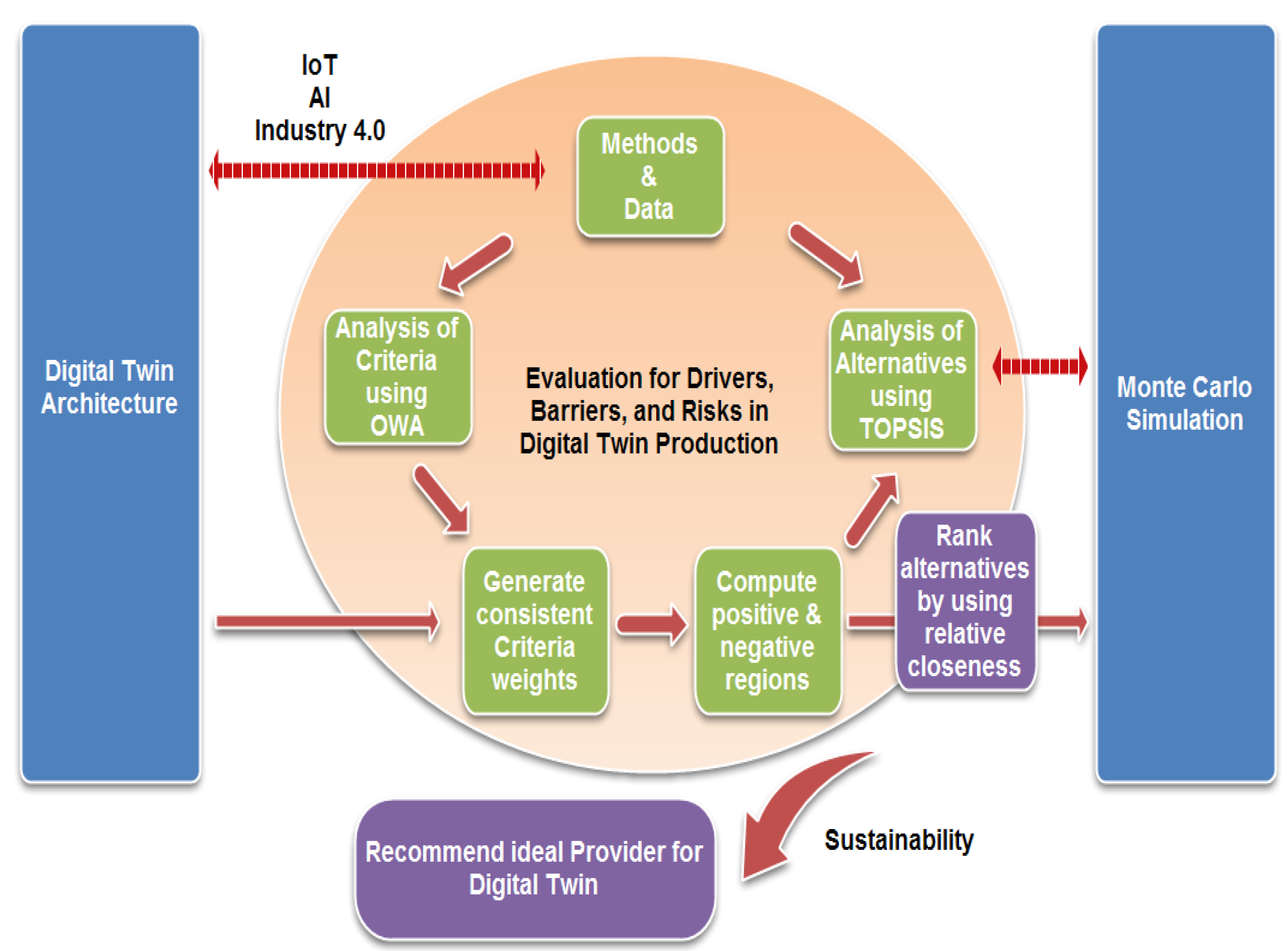
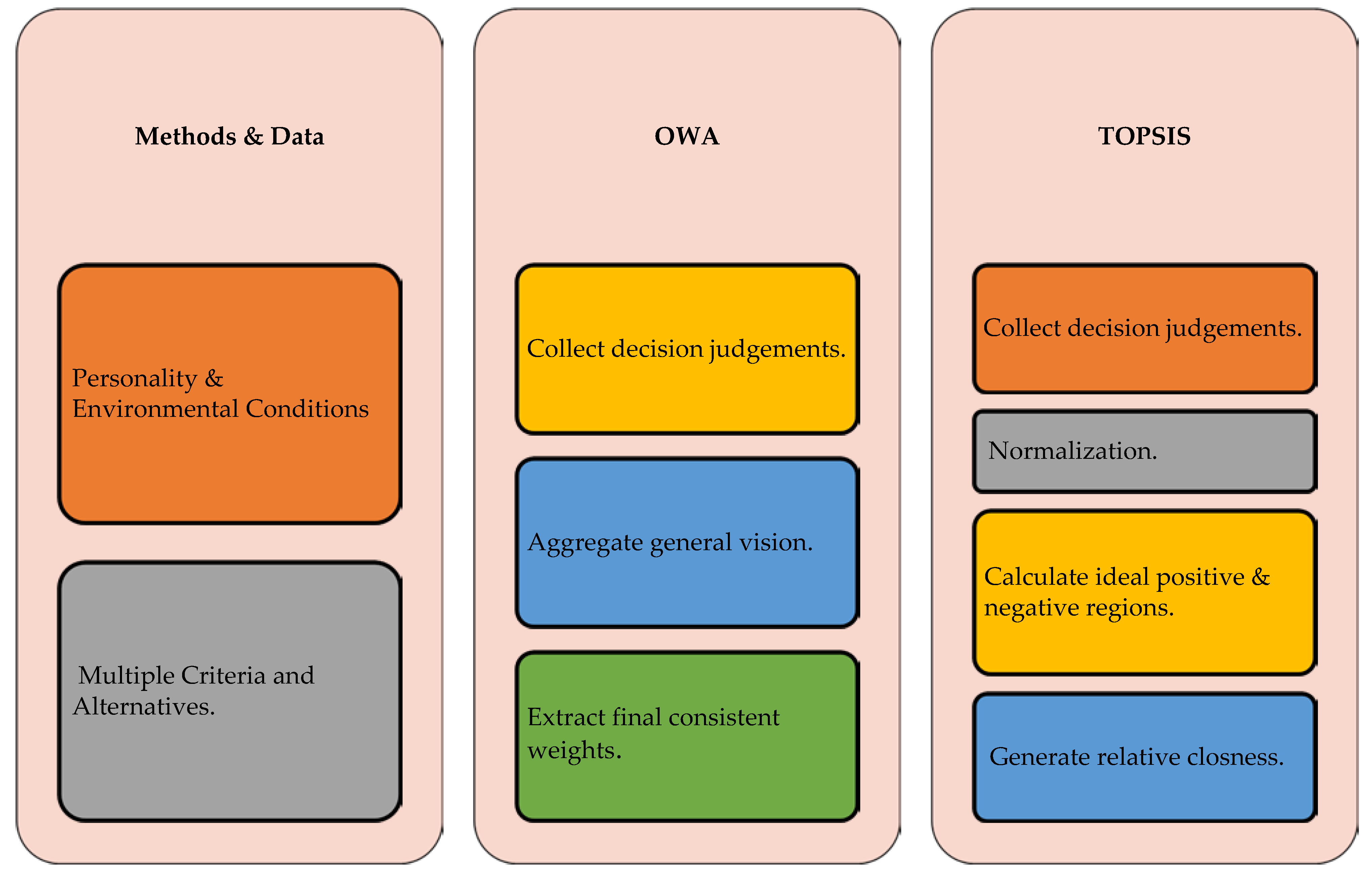
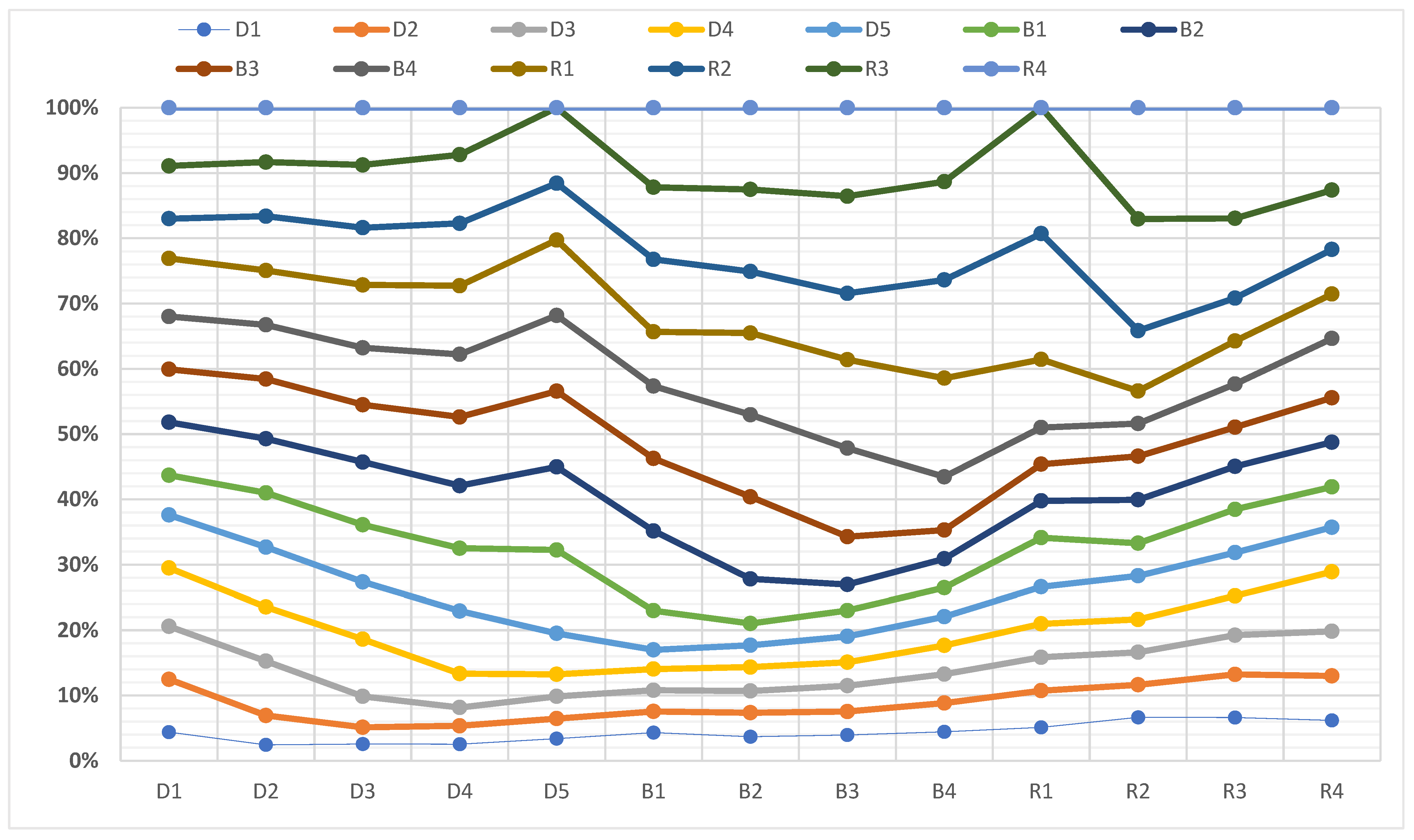
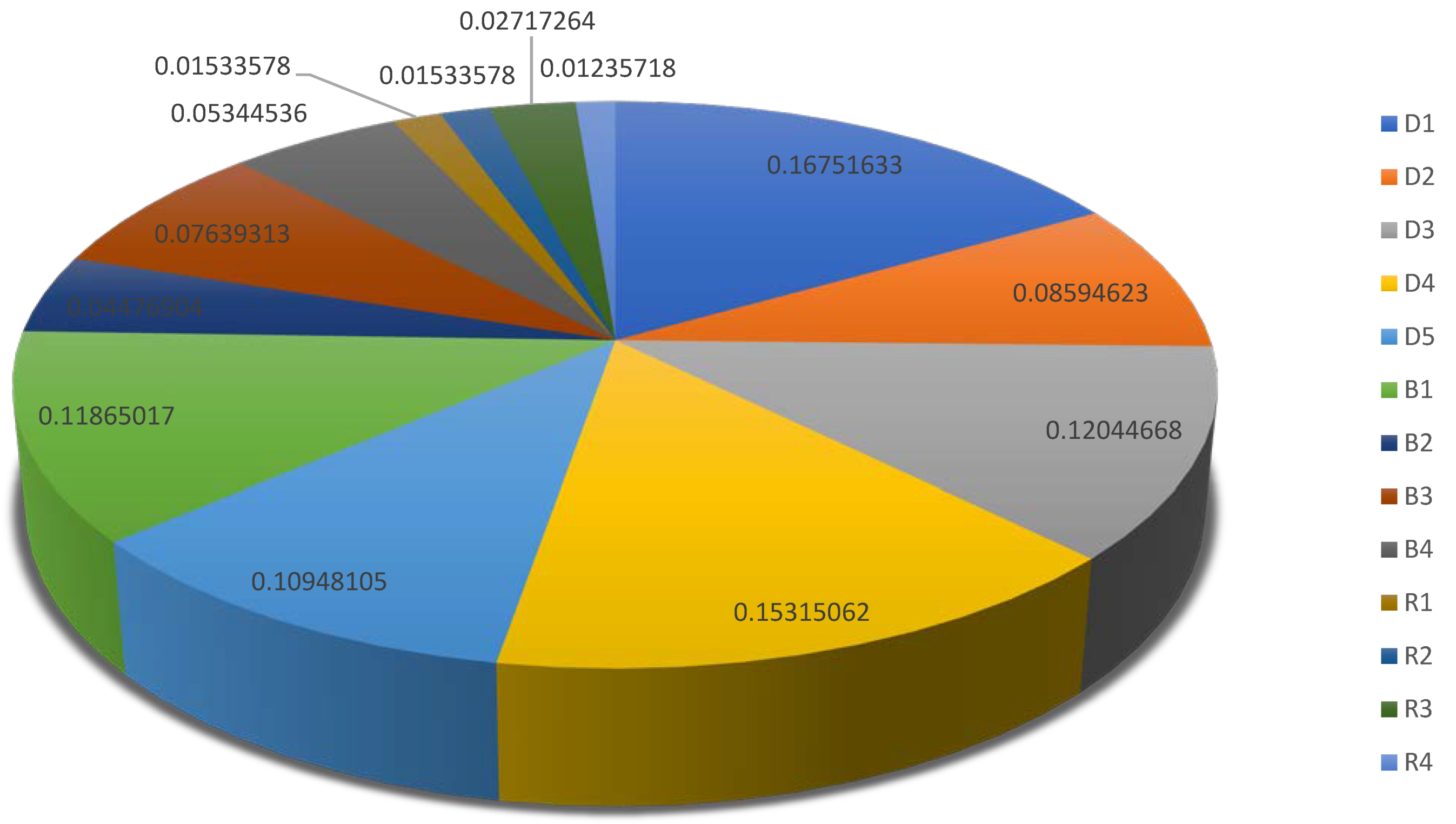
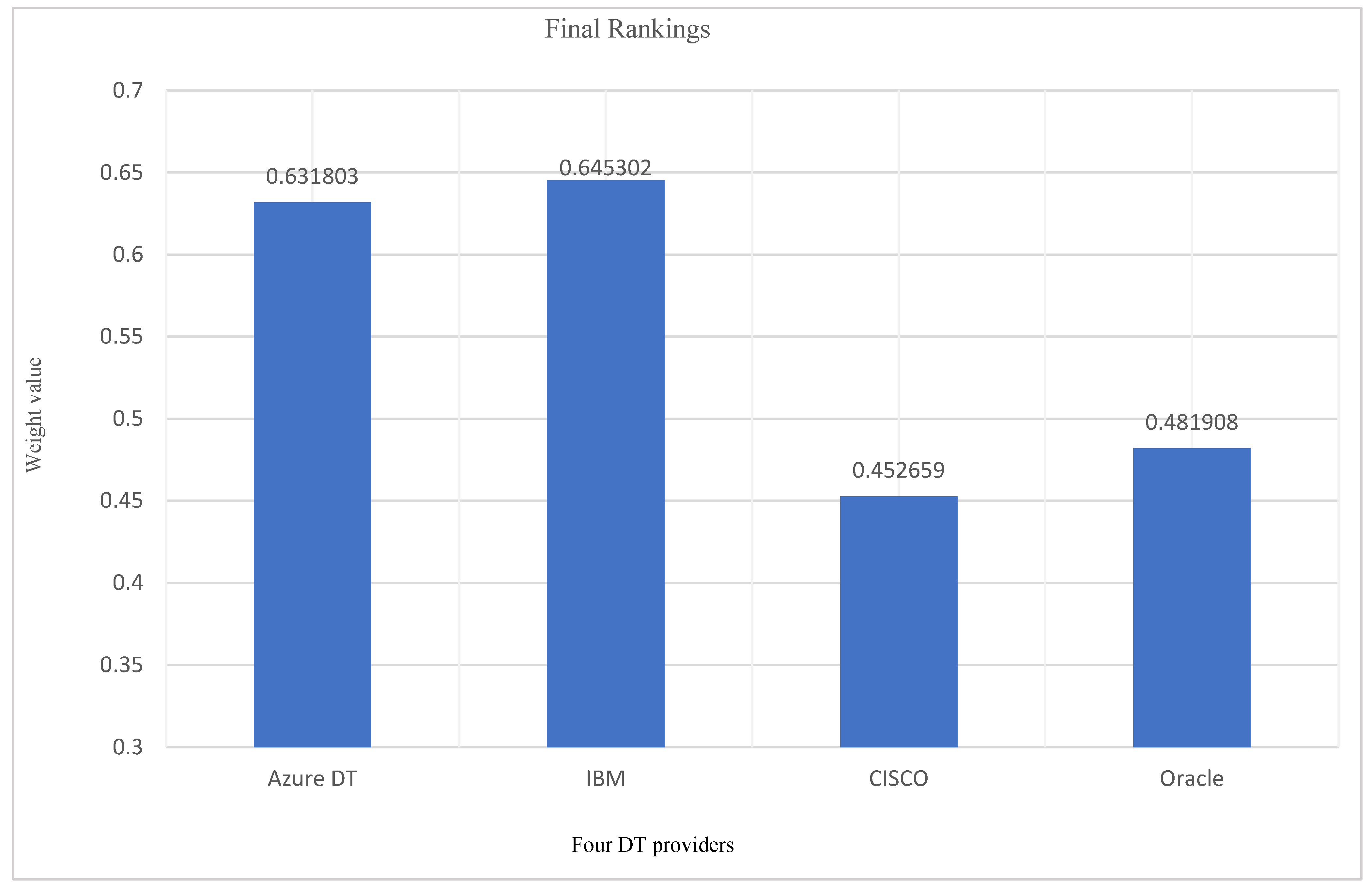
| Application | Explanation | Benefits |
|---|---|---|
| Blockchain enhances the sustainable development of the global economy, providing valuable benefits for either organizations or customers [30]. | Blockchain technology enhances capital markets to perform efficient operations such as securities and derivatives transactions [31], digital payments [32], cryptocurrency payments, and exchanges. |
| Citizenship services: used to determine citizens’ basic attributes (e.g., name, address, and other personal data) | The internet of agreements (IoA) establishes a connection between digital content and real materials; for example, it represents an IoA system to manage blockchain-related legal rights with respect to physical and IP rights [7]. |
| Public sectors: used to provide citizens with remote services such as virtual notaries, reputation, and dispute resolution | Applications can be used to attain distributed, efficient, authenticated, and inexpensive persistent official documents [33]. | |
| Electronic voting: the use of technology to remotely perform the process of elections can reduce cost and ensure democracy. | Blockchains provide decentralized peer-to-peer technology to assure confidence in election organizations [34]. | |
| As IoT has been widely adopted, IoT applications can be blended with blockchain technologies to acquire the needed capabilities for dedicated computation for the underlying devices [35]. | The application of decentralized IoT platforms can support blockchains (Novo, 2018). Moreover, the IoT can secure data exchange in multiple context-aware scenarios [36] with several interconnected smart devices. |
| In healthcare, blockchain technology provides a crucial role in various applications such as healthcare management, online patient access, sharing of patient medical data, user-oriented medical research, drug counterfeiting, clinical trials, and precision medicine [37]. | Blockchains can overcome challenges regarding the scientific credibility of findings in clinical trials and patients’ informed consent [38]. |
| Blockchains apply asymmetric cryptography to secure transactions between users, providing users with enhanced techniques for security, transparency, and traceability [39]. | Privacy and security with blockchains can be applied to many emerging fields, including big data [40], DNS (The Decentralized Library of Alexandria, 2015), distributed networks, and transactional privacy. |
| Blockchain technology is estimated to increase transparency and accountability in supply chain management to attain flexible supply chains [16]. | The applications of blockchain include the fields of visibility, optimization, and demand (IBM Corporation, 2016). Blockchain in logistics can be used to determine counterfeit products, enhance origin tracking [41], and allow customers and vendors to apply directly without any brokers. |
| Energy sector: blockchain applications can directly influence the terms of processes and platforms [42]. | Blockchains can be used for green energy production and renewable energy sources [43], create energy management schemes for electric vehicles, and facilitate decentralized energy sources [44]. | |
| Blockchains can store educational records and ensure security and privacy purposes [45]. | Blockchain applications can be used for educational records and reputations [46]. Blockchains can enhance data security and trust in digital infrastructure and credit management [45]. |
| The applications of blockchain technology can improve data management and facilitate audibility [47]. | The blockchain-enhanced data management can enable fast, simple, and coherent interactions across data providers. |
| ID | Concept | Factors | Explanations |
|---|---|---|---|
| D1 | Drivers | Security | Blockchain records are secured through cryptography [49]. Users across networks exchange their private and public keys to transactions and act as a personal digital signature. |
| D2 | Anonymity | Unidentifiable personal details are needed between users (sender or receiver) in the blockchain. In order to perform transactions, only the private and public keys are required, without the need to reveal any related identity information [50]. | |
| D3 | No Single Point of Trust | In the blockchain, the distributed ledger is decentralized technology to overcome competent authorities without any third party to a transaction, e.g., a banking transaction [51]. | |
| D4 | Fraudulence Reluctance | It is not easy for invaders to attack or alter any data on a blockchain [14]. Transactions are executed remotely and smartly without human intervention. | |
| D5 | Non-physicality | All physical transactions are transformed into digital ones. Digital transactions securely overcome any bank bills and reduce costs [28]. | |
| B1 | Barriers | Privacy | Unfortunately, the public blockchain has limitations in terms of data privacy. There are no privileges or grand rules, and all users can access any information in the distributed ledger [52]. |
| B2 | Data Storage | The huge amount of data generated from transactions and sensors are not suitable for storage on the blockchain. Public blockchains have restrictions on the amount of data stored [3]. | |
| B3 | Scalability | The blockchain must efficiently detect a wide-scale serialization with applicable scalability concerns [53]. Blockchain technology can efficiently trouble many users on networks. | |
| B4 | High Computation Power | The blockchain requires a great deal of computational power and electricity. Therefore, many researchers have focused on novel applications in the field of the energy sector [54]. | |
| R1 | Risk | Vulnerability | Smart and virtual contracts are conducive to vulnerabilities that can be exploited by hackers. The risks and opportunities of emerging business models are adopted to overcome vulnerabilities [55]. |
| R2 | Private key security | The private key is an essential security credential [56]. Therefore, if the private key is hacked or lost, it is challenging to trace the hacked data to permit recovery [57]. | |
| R3 | Criminal activity | Cryptocurrencies may be used for illegal issues, and competent authorities may not be able to detect or trace the real parties. | |
| R4 | Exposing identity | Hackers can identify and trace the IP address of users, then make illegal modifications that may lead to the loss of users’ cryptocurrencies; e.g., any payment transaction can change the original IP address to another to be received in the updated location by the hackers [3]. |
| Criteria | D1 | D2 | D3 | D4 | D5 | B1 | B2 | B3 | B4 | R1 | R2 | R3 | R4 |
|---|---|---|---|---|---|---|---|---|---|---|---|---|---|
| D1 | 1 | 1.843 | 1.85 | 2.03 | 1.85 | 1.388 | 1.848 | 1.85 | 1.843 | 2.03 | 1.388 | 1.843 | 2.03 |
| D2 | 0.542 | 1 | 1.85 | 1.843 | 2.03 | 1.85 | 1.843 | 2.03 | 1.848 | 1.85 | 1.85 | 1.843 | 1.85 |
| D3 | 0.539 | 0.542 | 1 | 1.848 | 1.843 | 1.843 | 2.03 | 1.85 | 1.843 | 2.03 | 1.85 | 2.03 | 1.848 |
| D4 | 0.491 | 0.542 | 0.541 | 1 | 1.85 | 1.848 | 1.85 | 2.03 | 1.85 | 2.03 | 1.843 | 2.03 | 1.388 |
| D5 | 0.539 | 0.491 | 0.542 | 0.539 | 1 | 2.03 | 2.03 | 1.848 | 1.85 | 1.843 | 1.388 | 1.843 | 1.85, |
| B1 | 0.720 | 0.539 | 0.542 | 0.541 | 0.491 | 1 | 2.03 | 1.85 | 1.848 | 1.388 | 1.85 | 1.843 | 2.03 |
| B2 | 0.541 | 0.542 | 0.491 | 0.539 | 0.491 | 0.491 | 1 | 1.85 | 1.85 | 1.843 | 1.388 | 1.85 | 1.843 |
| B3 | 0.539 | 0.491 | 0.539 | 0.491 | 0.541 | 0.539 | 0.539 | 1 | 1.85 | 1.85 | 1.388 | 2.03 | 1.85 |
| B4 | 0.542 | 0.541 | 0.542 | 0.539 | 0.539 | 0.541 | 0.539 | 0.539 | 1 | 1.85 | 1.843 | 1.843 | 1.388 |
| R1 | 0.491 | 0.539 | 0.491 | 0.491 | 0.542 | 0.720 | 0.542 | 0.539 | 0.539 | 1 | 1.85 | 1.85 | 1.85 |
| R2 | 0.720 | 0.539 | 0.539 | 0.542 | 0.720 | 0.539 | 0.720 | 0.720 | 0.542 | 0.539 | 1 | 1.85 | 1.843 |
| R3 | 0.542 | 0.542 | 0.491 | 0.491 | 0.542 | 0.542 | 0.539 | 0.491 | 0.542 | 0.539 | 0.539 | 1 | 1.388 |
| R4 | 0.491 | 0.539 | 0.541 | 0.720 | 0.539 | 0.491 | 0.542 | 0.539 | 0.720 | 0.539 | 0.542 | 0.720 | 1 |
| Criteria | Weights |
|---|---|
| D1 | 0.159799 |
| D2 | 0.081987 |
| D3 | 0.114898 |
| D4 | 0.146095 |
| D5 | 0.104437 |
| B1 | 0.113184 |
| B2 | 0.047362 |
| B3 | 0.080273 |
| B4 | 0.056109 |
| R1 | 0.016165 |
| R2 | 0.016165 |
| R3 | 0.038615 |
| R4 | 0.024911 |
| Criteria | D1 | D2 | D3 | D4 | D5 | B1 | B2 | B3 | B4 | R1 | R2 | R3 | R4 |
|---|---|---|---|---|---|---|---|---|---|---|---|---|---|
| D1 | 0.325 | 0.325 | 0.325 | 0.325 | 0.325 | 0.325 | 0.325 | 0.325 | 0.325 | 0.325 | 0.325 | 0.325 | 0.325 |
| D2 | 0.166 | 0.166 | 0.166 | 0.166 | 0.166 | 0.166 | 0.166 | 0.166 | 0.166 | 0.166 | 0.166 | 0.166 | 0.166 |
| D3 | 0.233 | 0.233 | 0.233 | 0.233 | 0.233 | 0.233 | 0.233 | 0.233 | 0.233 | 0.233 | 0.233 | 0.233 | 0.233 |
| D4 | 0.297 | 0.297 | 0.297 | 0.297 | 0.297 | 0.297 | 0.297 | 0.297 | 0.297 | 0.297 | 0.297 | 0.297 | 0.297 |
| D5 | 0.212 | 0.212 | 0.212 | 0.212 | 0.212 | 0.212 | 0.212 | 0.212 | 0.212 | 0.212 | 0.212 | 0.212 | 0.212 |
| B1 | 0.230 | 0.230 | 0.230 | 0.230 | 0.230 | 0.230 | 0.230 | 0.230 | 0.230 | 0.230 | 0.230 | 0.230 | 0.230 |
| B2 | 0.086 | 0.086 | 0.086 | 0.086 | 0.086 | 0.086 | 0.086 | 0.086 | 0.086 | 0.086 | 0.086 | 0.086 | 0.086 |
| B3 | 0.148 | 0.148 | 0.148 | 0.148 | 0.148 | 0.148 | 0.148 | 0.148 | 0.148 | 0.148 | 0.148 | 0.148 | 0.148 |
| B4 | 0.103 | 0.103 | 0.103 | 0.103 | 0.103 | 0.103 | 0.103 | 0.103 | 0.103 | 0.103 | 0.103 | 0.103 | 0.103 |
| R1 | 0.029 | 0.029 | 0.029 | 0.029 | 0.029 | 0.029 | 0.029 | 0.029 | 0.029 | 0.029 | 0.029 | 0.029 | 0.029 |
| R2 | 0.029 | 0.029 | 0.029 | 0.029 | 0.029 | 0.029 | 0.029 | 0.029 | 0.029 | 0.029 | 0.029 | 0.029 | 0.029 |
| R3 | 0.052 | 0.052 | 0.052 | 0.052 | 0.052 | 0.052 | 0.052 | 0.052 | 0.052 | 0.052 | 0.052 | 0.052 | 0.052 |
| R4 | 0.024 | 0.024 | 0.024 | 0.024 | 0.024 | 0.024 | 0.024 | 0.024 | 0.024 | 0.024 | 0.024 | 0.024 | 0.024 |
| Criteria | Weights |
|---|---|
| D1 | 0.16751633 |
| D2 | 0.08594623 |
| D3 | 0.12044668 |
| D4 | 0.15315062 |
| D5 | 0.10948105 |
| B1 | 0.11865017 |
| B2 | 0.04476904 |
| B3 | 0.07639313 |
| B4 | 0.05344536 |
| R1 | 0.01533578 |
| R2 | 0.01533578 |
| R3 | 0.02717264 |
| R4 | 0.01235718 |
| Alternatives/Criteria | D1 | D2 | D3 | D4 | D5 | B1 | B2 | B3 | B4 | R1 | R2 | R3 | R4 |
|---|---|---|---|---|---|---|---|---|---|---|---|---|---|
| Azure DT | 2.101 | 1.843 | 1.388 | 2.03 | 1.85 | 1.38 | 1.848 | 1.85 | 1.843 | 2.03 | 1.388 | 1.843 | 2.03 |
| IBM | 1.85 | 1 | 1.85 | 1.843 | 2.03 | 1.85 | 1.843 | 2.03 | 1.848 | 1.85 | 1.85 | 1.843 | 1.85 |
| CISCO | 1.85 | 2.101 | 1 | 1.848 | 1.843 | 1.38 | 2.03 | 1.38 | 1.843 | 2.03 | 1.85 | 2.03 | 1.848 |
| Oracle | 1.388 | 1.388 | 2.101 | 1.388 | 1.85 | 1.848 | 1.85 | 2.03 | 1.85 | 2.03 | 1.843 | 2.03 | 1.388 |
| Alternatives/Criteria | D1 | D2 | D3 | D4 | D5 | B1 | B2 | B3 | B4 | R1 | R2 | R3 | R4 |
|---|---|---|---|---|---|---|---|---|---|---|---|---|---|
| Azure DT | 0.092 | 0.046 | 0.048 | 0.090 | 0.058 | 0.047 | 0.026 | 0.045 | 0.031 | 0.010 | 0.006 | 0.021 | 0.015 |
| IBM | 0.081 | 0.025 | 0.064 | 0.082 | 0.064 | 0.063 | 0.026 | 0.049 | 0.031 | 0.009 | 0.009 | 0.021 | 0.014 |
| CISCO | 0.081 | 0.052 | 0.035 | 0.082 | 0.058 | 0.047 | 0.029 | 0.033 | 0.031 | 0.010 | 0.009 | 0.023 | 0.014 |
| Oracle | 0.060 | 0.034 | 0.073 | 0.061 | 0.058 | 0.063 | 0.026 | 0.049 | 0.031 | 0.010 | 0.009 | 0.023 | 0.010 |
| 0.092 | 0.052 | 0.073 | 0.090 | 0.064 | 0.063 | 0.029 | 0.049 | 0.031 | 0.010 | 0.009 | 0.023 | 0.015 | |
| 0.060 | 0.025 | 0.035 | 0.061 | 0.058 | 0.047 | 0.026 | 0.033 | 0.031 | 0.009 | 0.006 | 0.021 | 0.010 |
| Alternatives | Ranking | |||
|---|---|---|---|---|
| Azure DT | 0.065811 | 0.112928 | 0.631803 | 2 |
| IBM | 0.063398 | 0.115341 | 0.645302 | 1 |
| CISCO | 0.097831 | 0.080908 | 0.452659 | 4 |
| Oracle | 0.092603 | 0.086136 | 0.481908 | 3 |
Publisher’s Note: MDPI stays neutral with regard to jurisdictional claims in published maps and institutional affiliations. |
© 2022 by the authors. Licensee MDPI, Basel, Switzerland. This article is an open access article distributed under the terms and conditions of the Creative Commons Attribution (CC BY) license (https://creativecommons.org/licenses/by/4.0/).
Share and Cite
Nabeeh, N.A.; Abdel-Basset, M.; Gamal, A.; Chang, V. Evaluation of Production of Digital Twins Based on Blockchain Technology. Electronics 2022, 11, 1268. https://doi.org/10.3390/electronics11081268
Nabeeh NA, Abdel-Basset M, Gamal A, Chang V. Evaluation of Production of Digital Twins Based on Blockchain Technology. Electronics. 2022; 11(8):1268. https://doi.org/10.3390/electronics11081268
Chicago/Turabian StyleNabeeh, Nada A., Mohamed Abdel-Basset, Abduallah Gamal, and Victor Chang. 2022. "Evaluation of Production of Digital Twins Based on Blockchain Technology" Electronics 11, no. 8: 1268. https://doi.org/10.3390/electronics11081268
APA StyleNabeeh, N. A., Abdel-Basset, M., Gamal, A., & Chang, V. (2022). Evaluation of Production of Digital Twins Based on Blockchain Technology. Electronics, 11(8), 1268. https://doi.org/10.3390/electronics11081268









